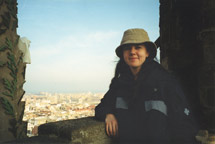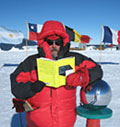Rafe Schindler in the LSST clean room. (Click on image for larger version.)
A Game of Tolerances
by Ken Kingery
Contamination is the enemy for Large Synoptic Survey Telescope collaborators Rafe Schindler and a team of SLAC scientists and technicians working in Light Assembly Building 33. The clean room,
which requires shoe covers, hair nets and immaculately cleaned nylon lab coats, will house the construction of the camera for the
Large Synoptic Survey Telescope (LSST). But before work begins on the three-ton camera, Schindler's team is building a suite of high vacuum chambers to test materials for use in its construction.
"We're starting early because this research on potential materials impacts the entire downstream design and construction of every other component in proximity to the optical elements of the camera," said Schindler.
Read more...
|
 2007 Pope Fellow:
Lori Stevens
by Ken Kingery

Lori Stevens at the top of Gaudi's Church of the
Sagrada Familia in Barcelona. (Click on image for larger version.) SLAC recently welcomed Lori Stevens, the fifth recipient of the annual Katherine Pope Fellowship. Stevens, a senior in physics at the University of California at Santa Cruz,
is working under Norman Graf on detector software development for the International Linear Collider.
"I was greeted on my first day with an amazing lunch at the Juneteenth celebration," said Stevens. "It was quite a nice way to begin a fellowship."
Originally an art student at San Jose State University, Stevens said she found
inspiration difficult to come by while under deadline. After a couple of years,
she decided to take a break from school and travel through Europe, Southeast
Asia, Israel and Nepal. While abroad, she discovered her hidden love of physics.
"While traveling I read a lot of books on physics and discussed the science with friends," she said. "I found that I really could do anything I wanted with my life."
After volunteering at an orphanage in Nepal and enjoying the beauty of the Himalayas, Stevens returned to the United States and her studies. But this time her schedule was full of physics and computer programming classes.
"I decided computer programming was a good skill for a physics major to have," said Stevens, who will be focusing on computer programming during her stay at SLAC.
In addition to her coursework, Stevens is a chess instructor for children and enjoys spinning records as a DJ. With her physics degree nearly completed, Stevens plans to attend graduate school with a focus on quantum or particle physics after her graduation next year.
|
Caution: Construction Continues on Sand Hill
by Kelen Tuttle
 Due to
construction along Sand Hill Road, traffic is currently being rerouted into a single lane in segments between Santa Cruz Avenue and I-280. Please use caution in this area, as construction workers will be on the job between 9:00 a.m. and 3:30 p.m. In addition, the closure of the bicycle lane requires
bicyclists to ride in the single open lane. Drivers are asked to be especially
conscientious of bicyclists in these areas. All construction along Sand Hill Road is scheduled to end by August 31, 2007. Due to
construction along Sand Hill Road, traffic is currently being rerouted into a single lane in segments between Santa Cruz Avenue and I-280. Please use caution in this area, as construction workers will be on the job between 9:00 a.m. and 3:30 p.m. In addition, the closure of the bicycle lane requires
bicyclists to ride in the single open lane. Drivers are asked to be especially
conscientious of bicyclists in these areas. All construction along Sand Hill Road is scheduled to end by August 31, 2007.
symmetry:
Launched into Science
by Pierre Schwob
 Sputnik, the first satellite sent into Earth orbit, was launched October 4, 1957—my 11th birthday, so I remember the date. It was also the first time I found my father seemingly interested in science and technology. Sputnik, the first satellite sent into Earth orbit, was launched October 4, 1957—my 11th birthday, so I remember the date. It was also the first time I found my father seemingly interested in science and technology.
I understood later that my dad's reaction had more to do with the fact that it was the communists who had launched the thing. Nonetheless, I was most impressed by the idea that one could tune a radio receiver to hear transmissions from a man-made object in space. I began to read what I could about radio, rockets, space, and the stars.
This opened a wonderful perspective for me: We humans are rather puny creatures, but we can think! Pascal's words "Man is but a reed... but he is a thinking reed" resonated strongly, as did "The universe is an infinite sphere whose center is everywhere and circumference nowhere."
My natural inclination is to understand things within their context. And I cannot imagine a better context-providing starting point than the study of cosmology and astronomy. The more I read, taking particular pleasure in the history of science and in the learning of the scientific method, the more I became fascinated by the astonishing advances made toward our understanding of the universe and our place in it. (Perhaps to Pascal's chagrin, this drove me to evolve into a comfortable agnosticism.)
Read more in symmetry...
|
Lab Announcements
|





 <%
Response.AddHeader "Last-modified", getArticleDate()
'Response.AddHeader "Last-modified","Mon, 01 Sep 1997 01:03:33 GMT"
'Monday, December 06, 2010
%>
<%
Response.AddHeader "Last-modified", getArticleDate()
'Response.AddHeader "Last-modified","Mon, 01 Sep 1997 01:03:33 GMT"
'Monday, December 06, 2010
%>